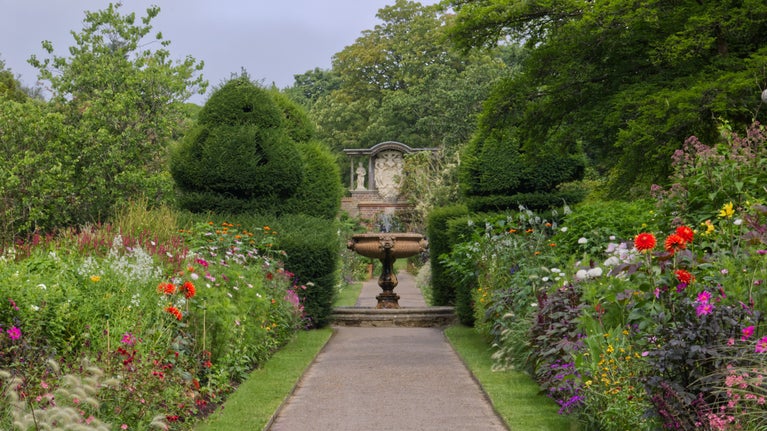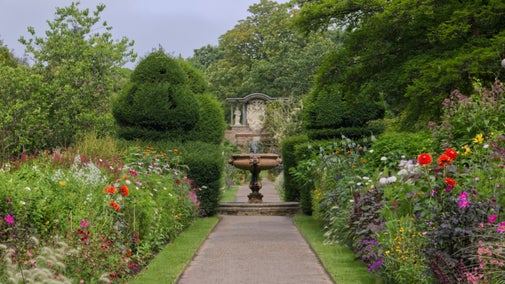
Gardens and landscapes
Find out more about the historical landscapes that the talented garden teams work hard to conserve at the places you love to visit.

Sunken lanes are roads or tracks that sit below the general level of the surrounding land, often by several metres. They’re formed by the passage of people, vehicles and animals – as well as the action of running water – over time. They may be currently active (incising) or inactive and they’re often hundreds of years old. You can see examples of this at many National Trust places including Dunstable Downs and Leith Tower Hill.
Sunken lanes are found throughout Europe. In general, they’re associated with areas of soft rocks and a long history of human occupation. They’re particularly common in areas with soils derived from wind-blown dust (‘loess’).
In France, they’re known as ‘chemin creux’, and in Germany as ‘Holweg’. 'Holloways' is also a common name for them in England.
In southern England, they’re impressively developed on the Bridport Sands around Yeovil and on the Lower Greensand in Surrey and Sussex.
It is difficult to date sunken lanes. Those around Midhurst in West Sussex appear to connect valley-bottom villages at crossing points of the River Rother with upland areas that would have been a timber and pasture resource. The movement of animals from winter grazing in the valleys to summer grazing on more upland areas – known as ‘transhumance’ – and is practised globally. The villages in the area are of Saxon origin, which suggests the lanes are at least 1,500 years old.
Sunken lanes have acted as strategic routeways in times of battle. They are repositories of geological information (exposures in roadside banks), and provide habitats for animals such as badgers, foxes, rabbits and birds as well as routeways for bats.
Gilbert White, vicar of Selbourne, was well aware of sunken lanes in the South Downs, and wrote about them in a letter to celebrated naturalist and traveller, Thomas Pennant, in the mid-1760s:
One of the main routes between fields and rivers is via sunken lanes. Sediments travel along them from valley-side sources (mainly arable fields) and when it reaches the rivers it can lead to problems for fish breeding and invertebrates, as has been seen in the River Rother. At times of heavy rainfall, muddy flows can move more quickly down sunken lanes and cause repeated flooding of villages, as has been seen in the village of Easebourne in West Sussex, before reaching the river.
Sunken lanes are much neglected features of our landscape. They form essential networks for rural communication created over hundreds of years of human, vehicular and animal movements and aided by running water. They’re of interest to both geologists and ecologists, and in certain areas they’ve had a profound impact on patterns of flooding and river pollution.
Written by John Boardman, a geomorphologist at the University of Oxford who has worked on land degradation and soil erosion in both the UK and South Africa for 40 years.

Find out more about the historical landscapes that the talented garden teams work hard to conserve at the places you love to visit.

A hub for multi-disciplinary research projects and research engagement at the University of Oxford
Find out more about our Trusted Source articles, which were created in partnership with the University of Oxford, and explore topics related to the special places in our care.

Discover more about the history of the plants, gardens and landscapes in our care.

The history of the English landscape garden is infused with political meaning. Learn the history and political stories behind this garden style characterised by structured informality.

Find out more about the picturesque aesthetic style and how it became a fashionable choice for wealthy estates in the 18th century. Discover more about the people who influenced the movement.

Discover the evolution in garden buildings, from exclusive hothouses for rare new finds to the cornerstones of every garden today.

Status symbol, hunting ground and a source of building materials. Discover the important roles deer parks played in aristocratic and royal society.

A ha-ha is a type of sunken fence used in landscaped gardens to create the illusion of a continuous rolling lawn whilst keeping livestock out. They were popular in the 18th century across Britain.

Open space campaigners sought to preserve countryside for recreation. Discover the history of the movement and how it inspired our work.
